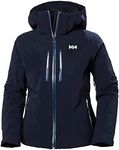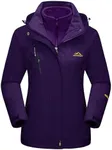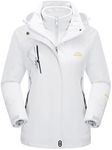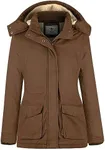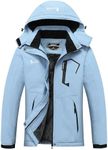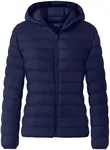Buying Guide for the Best Womens Ski Jackets
Choosing the right women's ski jacket is essential for ensuring comfort, warmth, and protection while enjoying your time on the slopes. The perfect ski jacket will keep you dry, regulate your body temperature, and allow for freedom of movement. To make an informed decision, it's important to understand the key specifications and how they align with your needs and preferences.Waterproof RatingThe waterproof rating of a ski jacket indicates how well it can keep you dry in wet conditions. This rating is measured in millimeters (mm) and ranges from 5,000mm to 20,000mm or more. A higher rating means better waterproofing. For light snow or occasional skiing, a rating of 5,000mm to 10,000mm is sufficient. For heavy snow or wet conditions, look for a rating of 15,000mm or higher. Consider your skiing environment and typical weather conditions to choose the right level of waterproofing.
InsulationInsulation in a ski jacket helps retain body heat and keep you warm. There are two main types: down and synthetic. Down insulation is lightweight and highly effective in dry, cold conditions, but it loses its insulating properties when wet. Synthetic insulation is bulkier but retains warmth even when damp. If you ski in very cold, dry conditions, down might be the best choice. For wetter climates or if you prefer a more versatile jacket, synthetic insulation is a better option.
BreathabilityBreathability refers to how well a jacket allows moisture from sweat to escape, keeping you dry and comfortable. This is measured in grams (g) and typically ranges from 5,000g to 20,000g. Higher breathability ratings are better for high-intensity activities where you might sweat more. If you are an active skier who spends a lot of time on challenging runs, look for a jacket with a breathability rating of 15,000g or higher. For more casual skiing, a rating of 5,000g to 10,000g should suffice.
Fit and MobilityThe fit of a ski jacket affects your comfort and range of motion. Jackets come in various fits, such as slim, regular, and relaxed. A slim fit is more form-fitting and stylish but may restrict movement. A regular fit offers a balance between comfort and mobility, while a relaxed fit provides the most freedom of movement but can be bulkier. Consider your skiing style and personal preference for fit. If you prioritize performance and agility, a regular or slim fit might be best. For maximum comfort and layering, a relaxed fit is ideal.
VentilationVentilation features, such as pit zips or mesh-lined vents, help regulate your body temperature by allowing excess heat to escape. These are especially useful during intense skiing sessions or warmer days. If you tend to overheat easily or ski in varying temperatures, look for jackets with ample ventilation options. This will help you stay comfortable and prevent overheating.
Pockets and StoragePockets and storage options in a ski jacket are important for carrying essentials like your phone, wallet, ski pass, and snacks. Look for jackets with a variety of pockets, including secure zippered pockets and specialized ones like a ski pass pocket on the sleeve. Think about what you typically carry with you on the slopes and choose a jacket with enough storage to meet your needs.
HoodA hood on a ski jacket provides extra protection against wind and snow. Hoods can be removable, adjustable, or helmet-compatible. If you often ski in harsh weather conditions, an adjustable or helmet-compatible hood is beneficial. For more versatility, a removable hood allows you to customize your jacket based on the weather. Consider how often you wear a helmet and the typical weather conditions to decide on the best hood option for you.
SeamsSeams in a ski jacket can be critically taped or fully taped. Critically taped seams are sealed in key areas to prevent water from seeping in, while fully taped seams offer complete waterproofing. If you ski in wet conditions or heavy snow, fully taped seams provide the best protection. For drier conditions, critically taped seams may be sufficient. Assess the typical weather conditions you face to determine the level of seam sealing you need.


